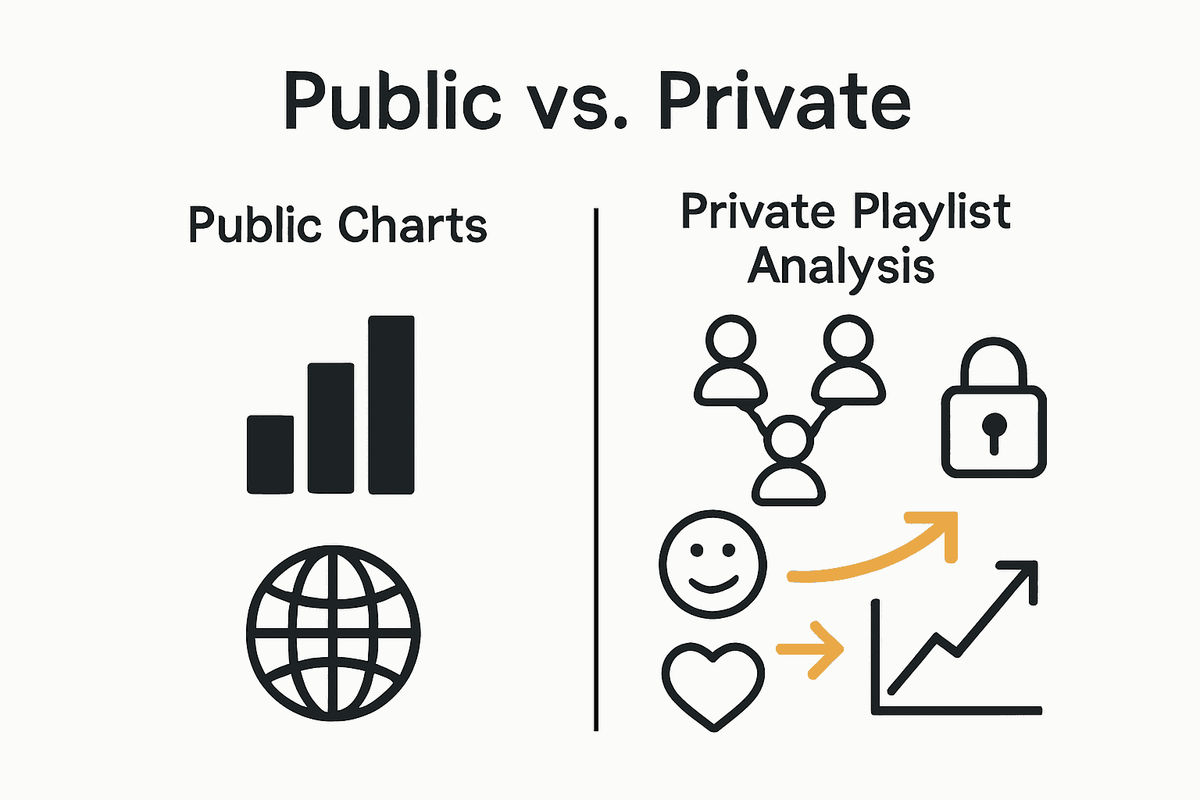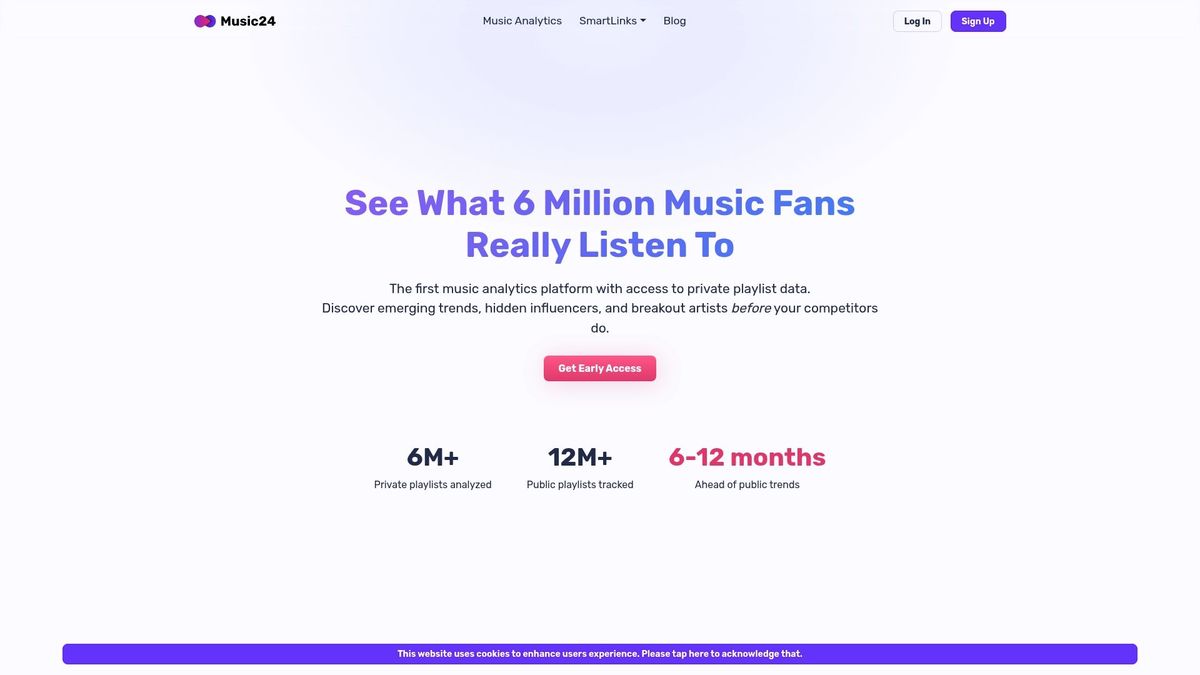Over 60 percent of music listeners curate private playlists that never appear on public charts. These hidden selections reveal surprising truths about genuine music preferences and emotional states. By analyzing private playlists, researchers and industry professionals can decode shifting musical trends, influencer impact, and unconscious patterns long before they reach the mainstream. Dive into how private playlist analysis is reshaping our understanding of musical taste and artist discovery.
Table of Contents
- Defining Private Playlist Analysis Methods
- Types of Data Extracted From Playlists
- Detecting Trends and Influencer Impact
- Industry Applications and Real-World Use Cases
- Risks, Limitations, and Ethical Considerations
Key Takeaways
| Point | Details |
|---|---|
| Private Playlist Analysis | This method reveals authentic listener preferences and psychological states that conventional public metrics cannot provide. |
| Data Extraction Techniques | Advanced algorithms decode preferences through emotional metrics, genre transitions, and curator impacts to predict trends. |
| Industry Applications | Insights gained from private playlists are utilized for artist discovery, targeted marketing, and enhanced recommendation systems. |
| Ethical Considerations | Maintaining user privacy and addressing algorithmic bias are critical in the implementation of playlist analysis methods. |
Defining Private Playlist Analysis Methods
Private playlist analysis represents a sophisticated approach to understanding music consumption patterns by examining personalized, non-public playlist collections that reveal authentic listener preferences. Unlike public streaming charts, these private collections offer unprecedented insights into genuine musical discovery and individual taste formations.
The methodology involves sophisticated data extraction techniques that anonymize and aggregate playlist data while preserving individual privacy. Researchers are increasingly recognizing the potential of these collections to decode complex emotional and psychological landscapes. According to Frontiers in Psychology, playlist choices can actually reflect intricate psychological states, providing a nuanced window into listener mental frameworks.
Key private playlist analysis methods typically include:
- Emotion Recognition: Analyzing lyrical content and musical attributes to understand psychological resonance
- Genre Blending Tracking: Identifying emerging cross-genre trends before they become mainstream
- Curator Influence Mapping: Determining how specific playlist creators shape musical discovery
- Temporal Trend Analysis: Examining how playlist compositions evolve over time
These analysis techniques go beyond traditional metrics by focusing on the organic discovery of music. MDPI research demonstrates how advanced keyword and phrase recognition can unpack the emotional dimensions of playlist curation, revealing that playlists are far more than simple song collections—they are deeply personal narratives of musical experience.
By leveraging anonymized private playlist data, music industry professionals can gain predictive insights into emerging artist trends, listener preferences, and potential breakout genres long before they become visible through conventional public metrics.
Types of Data Extracted From Playlists
Private playlist data extraction represents a complex process of decoding musical preferences through multiple sophisticated analytical dimensions. Music industry professionals leverage advanced techniques to transform seemingly random song collections into rich, actionable insights about listener behavior and emerging trends.
Cornell University research reveals breakthrough methodologies in playlist data analysis, demonstrating how algorithms can model playlists as intricate Markov chains that predict song sequences without relying solely on traditional content-based features. This approach allows for nuanced understanding of listener patterns that go far beyond surface-level metrics.
Key types of data typically extracted from private playlists include:
- Temporal Sequence Data: Order and progression of tracks
- Emotional Resonance Metrics: Mood and psychological connection between songs
- Genre Transition Patterns: How listeners move between musical styles
- Curator Influence Indicators: Impact of specific playlist creators
- Track Relationship Mapping: Implicit connections between different songs
CEUR Workshop Proceedings further illuminate the complexity of playlist data by highlighting how individual track evaluations contribute to holistic playlist experiences. Researchers have discovered that factors like perceived diversity and the "peak-end effect" dramatically influence overall playlist attractiveness, suggesting that data extraction is not just about individual tracks but their collective narrative.
Ultimately, understanding types of playlist data transforms raw musical selections into predictive intelligence, enabling music industry professionals to anticipate listener trends, discover emerging artists, and craft more targeted engagement strategies.

Detecting Trends and Influencer Impact
Identifying emerging music trends and understanding influencer impact requires sophisticated analytical approaches that go beyond traditional metrics. Private playlist data offers an unprecedented window into authentic musical discovery and listener behavior patterns that traditional public streaming charts cannot reveal.
Diva Portal research highlights the critical nuance of user behavior in playlist creation, revealing that manually curated playlists often represent more than random collections—they are deliberate expressions of musical identity and emotional connection. These insights become crucial for understanding how trends actually emerge and propagate through listener networks.
Key strategies for detecting trends and measuring influencer impact include:
- Network Propagation Analysis: Tracking how songs spread across interconnected playlists
- Curator Influence Mapping: Identifying playlist creators with significant trend-setting capabilities
- Genre Transition Patterns: Analyzing how musical styles blend and transform
- Early Adoption Indicators: Recognizing signals of emerging artist popularity
- Emotional Resonance Tracking: Understanding psychological connections between tracks
Preprints research introduces a groundbreaking mathematical model that quantifies consumer emotional utility in playlist creation, providing a scientific framework for predicting music consumer behavior. This approach transforms trend detection from subjective observation to a data-driven predictive science.
To gain deeper insights, music professionals can learn how to detect music trends early, leveraging advanced analytical techniques that uncover hidden patterns in private playlist ecosystems before they become mainstream phenomena.
Industry Applications and Real-World Use Cases
Private playlist analysis has transformed from a theoretical concept to a powerful strategic tool across multiple sectors of the music industry. By unlocking deep insights from personalized playlist data, professionals can make more nuanced, predictive decisions that go far beyond traditional market research approaches.
ISMIR Archives research demonstrates breakthrough techniques in understanding music relevance, introducing unsupervised learning methods that can model connections between songs and playlist titles in a shared latent space. This sophisticated approach enables unprecedented precision in music retrieval and recommendation strategies.
Key industry applications of private playlist analysis include:
- A&R Discovery: Identifying emerging artists before mainstream recognition
- Marketing Segmentation: Creating hyper-targeted audience personas
- Royalty Distribution: More accurate tracking of song performance
- Recommendation Engine Development: Building more intelligent music suggestion systems
- Artist Development: Understanding listener preferences and emotional connections
ACM RecSys Challenge research highlights the complexity of music recommendation, showcasing various approaches like collaborative filtering and popularity-based recommendations that demonstrate the intricate science behind playlist continuation and music discovery.
For music industry professionals seeking to leverage these advanced analytical techniques, understanding playlist data applications can provide a critical competitive advantage in an increasingly data-driven musical landscape.
Risks, Limitations, and Ethical Considerations
Private playlist analysis represents a powerful analytical approach, but it also demands rigorous ethical scrutiny and careful implementation to protect user privacy and maintain data integrity. The sophisticated insights gained must be balanced against potential risks of data misuse and algorithmic bias.
CEUR Workshop Proceedings highlight the complex challenge of designing playlist algorithms that respect listener preferences while maintaining ethical boundaries. Their research demonstrates that understanding desired playlist characteristics like homogeneity and diversity requires nuanced approaches that go beyond simple data extraction.
Key ethical considerations and potential risks include:
- Data Anonymization: Ensuring individual user identities remain completely protected
- Consent Protocols: Implementing transparent user agreement mechanisms
- Algorithmic Bias Detection: Identifying and mitigating potential discriminatory patterns
- Psychological Impact Assessment: Understanding potential emotional manipulation risks
- Transparency in Data Usage: Clearly communicating how playlist data will be utilized
Altmetrics research provides additional context for understanding the broader implications of digital metrics, emphasizing the importance of developing alternative measurement approaches that prioritize ethical data collection and usage.
Music industry professionals must remain vigilant about these considerations, understanding the complex landscape of playlist data ethics to maintain trust and integrity in emerging music analytics technologies.

Unlock the Power of Private Playlist Analysis for Breakthrough Music Insights
Understanding the complex landscape of private playlist data presents a major challenge for music professionals seeking to predict emerging trends and discover rising artists before they hit mainstream awareness. This article highlights the importance of exploring emotion recognition, curator influence mapping, and temporal trend analysis to decode authentic listener behavior from private playlists. If you want to overcome the limitations of public metrics and harness the full potential of these hidden music discovery patterns, specialized tools are essential.
Music24.com offers exactly that. Our advanced platform analyzes millions of anonymized private playlists to reveal real-time genre blending, micro-trends, and influencer impact—all before they show up on public charts. With a deep focus on predictive analytics and early artist identification, Music24 empowers record labels, A&R teams, and marketers to make smarter, data-driven decisions that put them ahead of the competition.
Explore how private playlist data can transform your approach to music discovery and marketing with Music24.com.

Discover emerging artists and capture authentic audience insights now by visiting Music24.com. Don't wait for trends to appear publicly—get the edge today and turn hidden playlist data into your most valuable resource.
Frequently Asked Questions
What are the primary methods used in private playlist analysis?
Private playlist analysis utilizes methods such as emotion recognition, genre blending tracking, curator influence mapping, and temporal trend analysis to understand listener preferences and musical trends.
How does private playlist data differ from public streaming charts?
Private playlist data offers insights into genuine musical discovery and individual taste formations, unlike public streaming charts, which often reflect more mainstream or commercial popularities.
What types of data can be extracted from private playlists?
Key data extracted from private playlists includes temporal sequence data, emotional resonance metrics, genre transition patterns, curator influence indicators, and track relationship mapping, providing a comprehensive view of listener behavior.
What are the ethical considerations of private playlist analysis?
Ethical considerations include ensuring data anonymization, implementing consent protocols, detecting algorithmic bias, assessing the psychological impact, and maintaining transparency in how playlist data is utilized.
Recommended
- Role of Private Playlist Data: Complete Guide - Blog - Music24.com
- Understanding the Role of Playlist Data in Music Industry - Blog - Music24.com
- Understanding Playlist Data Analysis Guide for Music Pros - Blog - Music24.com
- How to Leverage Private Playlist Data for Artist Growth - Blog - Music24.com
- 16-30 Step-by-Step Self-Improvement Guide & Tier List Summary - AI Video Summary by SummYT
- How to Find New Music That You’ll Love in 2025 | Prodcast


